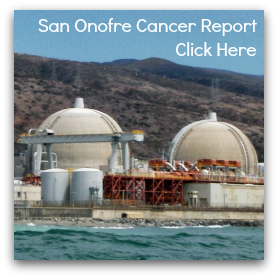 |
Nuclear Reactors, On Fault Lines In Tsunami Hazard Zones Equal Fukushimas
Decommission Diablo Canyon |
The two Diablo Canyon
nuclear power reactors (Diablo Canyon) in
San Luis Obispo (SLO) County are aging. They began operation in 1984 and 1985, respectively.
They are the only California nuclear power reactors still operating to produce electricity, after the San Onofre reactors were closed in June 2013. In 2010, 465,521 people lived within 50 miles of the plant.
As of 2010, the
Diablo Canyon nuclear power plant held 1126 metric tons of high-level radioactive waste, containing more radioactivity than that released during the
Chernobyl disaster of 1986. Diablo Canyon emitted more highly-toxic liquid tritium into the environment than any U.S. plant during the late 2000s.
A 2013 study by the
Union of Concerned Scientists concluded that the discovery of “a previously unknown earthquake fault line running as close as 2,000 feet from Diablo Canyon’s two reactors…could cause more ground motion during an earthquake than the plant was designed to withstand. Since this new fault was discovered, the NRC [Nuclear Regulatory Commission] has not demonstrated that the reactors meet agency safety standards.”
Average radioactive Strontium-90 (
Sr-90) levels in baby teeth from San Luis Obispo and
Santa Barbara counties were 30.8% greater than the Sr-90 levels in all California baby teeth tested. In
the state of California, Sr-90 levels in baby teeth rose steadily, increasing 50.2% in children born in the late 1990s vs. the late 1980s. Nuclear power plants are the only current source of Sr-90 emissions into the environment.
Major findings about local health patterns around the Diablo Nukes include:
1. Since the Diablo Canyon nuclear power plant opened in the mid-1980s,
San Luis Obispo County has changed from a relatively low-cancer to a high-cancer county.
2. Due to increases in the San Luis Obispo County cancer rate during 2001-2010, an additional 738 people were diagnosed with cancer.
3. Cancer incidence in San Luis Obispo County rose from 0.4% below to 6.9% above the average for the state of California during the time period of 1988-1990 to 2003-2010. The current cancer rate is the highest of all 20 counties in southern California.
4. After Diablo Canyon began operating, significant rapid increases occurred for the incidence of thyroid and female breast cancer in San Luis Obispo County, both highly radiosensitive cancers.
5. After Diablo Canyon began operating, infant mortality in San Luis Obispo County rose significantly.
6. After Diablo Canyon began operating, child/adolescent cancer mortality in the county rose rapidly.
7. Melanoma incidence in San Luis Obispo County soared from 3.6% above to 130.2% above the state incidence rate during the period from 1988-1990 to 2003-2010, and is now the highest of all California counties.
8. Cancer mortality for people of all ages in San Luis Obispo County rose from 5.1% below to 1.4% above California from 1988-1990 to 2008-2010, making SLO the 25thhighest county in the state (up from 43rd highest).
9. The ratio of babies born at very low-weight (below 3 pounds, 4 ounces) rose 45.0% higher in the 9 San Luis Obispo County zip codes closest to Diablo Canyon, versus the other more distant 10 county zip codes.
10. The ratio of all-cause mortality rose 47.9% higher in the 9 San Luis Obispo County zip codes closest to Diablo Canyon, versus the other more distant 10 county zip codes.
11. In the 10 zip code areas in Santa Barbara County closest to Diablo Canyon, there was a greater rise in the rates of infant mortality (61.7%), low weight births (40.2%) and total mortality (19.1%), than in the 5 zip codes areas in the city of Santa Barbara, located approximately 90 miles from the reactors.
12. The major findings of this report show increases in various rates of disease and death in San Luis Obispo County, as compared to the state of California, since the 1980s (before plant startup and during its early years of operation). This includes increases in infant mortality, child/adolescent cancer mortality, cancer incidence for all ages (especially thyroid, female breast, and melanoma), and cancer mortality for all ages.







